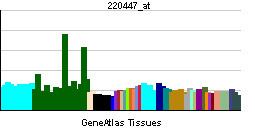Entrez 11255 | Ensembl ENSG00000101180 | |
 | ||
External IDs MGI: 2139279 HomoloGene: 5232 GeneCards: HRH3 | ||
Histamine H3 receptors are expressed in the central nervous system and to a lesser extent the peripheral nervous system, where they act as autoreceptors in presynaptic histaminergic neurons, and also control histamine turnover by feedback inhibition of histamine synthesis and release. The H3 receptor has also been shown to presynaptically inhibit the release of a number of other neurotransmitters (i.e. it acts as an inhibitory heteroreceptor) including, but probably not limited to dopamine, GABA, acetylcholine, noradrenaline, histamine and serotonin.
Contents
The gene sequence for H3 receptors expresses only about 22% and 20% homology with both H1 and H2 receptors respectively.
Tissue distribution
Function
Like all histamine receptors, the H3 receptor is a G-protein coupled receptor. The H3 receptor is coupled to the Gi G-protein, so it leads to inhibition of the formation of cAMP. Also, the β and γ subunits interact with N-type voltage gated calcium channels, to reduce action potential mediated influx of calcium and hence reduce neurotransmitter release. H3 receptors function as presynaptic autoreceptors on histamine-containing neurons.
The diverse expression of H3 receptors throughout the cortex and subcortex indicates its ability to modulate the release of a large number of neurotransmitters.
H3 receptors are thought to play a part in the control of satiety.
Isoforms
There are at least six H3 receptor isoforms in the human, and more than 20 discovered so far. In rats there have been six H3receptor subtypes identified so far. Mice also have three reported isoforms. These subtypes all have subtle difference in their pharmacology (and presumably distribution, based on studies in rats) but the exact physiological role of these isoforms is still unclear.
Agonists
There are currently no therapeutic products acting as selective agonists for H3 receptors, although there are several compounds used as research tools which are reasonably selective agonists. Some examples are:
Antagonists
These include:
Therapeutic potential
This receptor has been proposed as a target for treating sleep disorders. The receptor has also been proposed as a target for treating neuropathic pain.
Because of its ability to modulate other neurotransmitters, H3 receptor ligands are being investigated for the treatment of numerous neurological conditions, including obesity (because of the histamine/orexinergic system interaction), movement disorders (because of H3 receptor-modulation of dopamine and GABA in the basal ganglia), schizophrenia and ADHD (again because of dopamine modulation) and research is underway to determine whether H3 receptor ligands could be useful in modulating wakefulness (because of effects on noradrenaline, glutamate and histamine).
